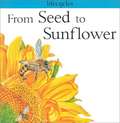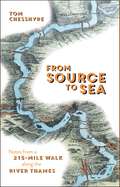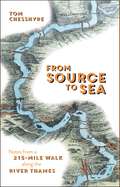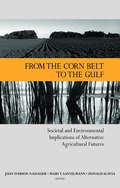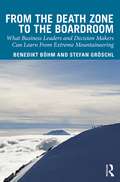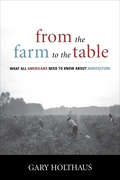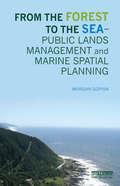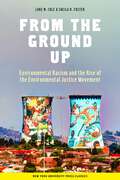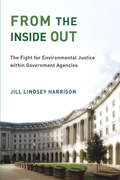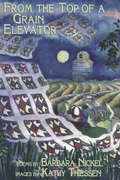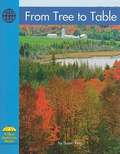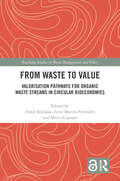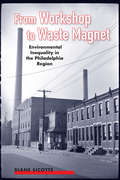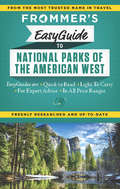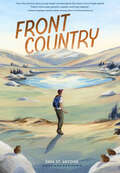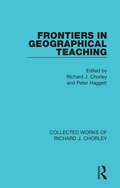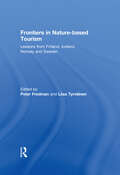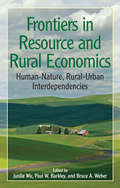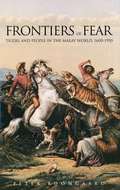- Table View
- List View
From Seed to Sunflower
by Dr Gerald LeggThis basic introduction uses the example of a sunflower to describe the year-long process by which a seed becomes a plant that can grow seeds of its own. Though the illustrations often employ interesting perspectives, their tones are unappealing garish. Brief Sunflower Facts and a growth time line are appended.
From Source to Sea: Notes from a 215-Mile Walk Along the River Thames
by Tom ChesshyreAuthors, artists and amblers have always felt the pull of the Thames, and now Tom Chesshyre is following in their footsteps. He’s walking more than 200 miles from the Cotswolds to the North Sea. Seeing some familiar sights through new eyes, Chesshyre explores the living present and remarkable past of England’s longest and most iconic river.
From Source to Sea: Notes from a 215-Mile Walk Along the River Thames
by Tom ChesshyreAuthors, artists and amblers have always felt the pull of the Thames, and now Tom Chesshyre is following in their footsteps. He’s walking more than 200 miles from the Cotswolds to the North Sea. Seeing some familiar sights through new eyes, Chesshyre explores the living present and remarkable past of England’s longest and most iconic river.
From Source to Sea: Notes from a 215-Mile Walk Along the River Thames
by Tom ChesshyreAuthors, artists and amblers have always felt the pull of the Thames, and now Tom Chesshyre is following in their footsteps. He’s walking more than 200 miles from the Cotswolds to the North Sea. Seeing some familiar sights through new eyes, Chesshyre explores the living present and remarkable past of England’s longest and most iconic river.
From Source to Sea: Notes from a 215-Mile Walk Along the River Thames
by Tom ChesshyreAuthors, artists and amblers have always felt the pull of the Thames, and now Tom Chesshyre is following in their footsteps. He’s walking more than 200 miles from the Cotswolds to the North Sea. Seeing some familiar sights through new eyes, Chesshyre explores the living present and remarkable past of England’s longest and most iconic river.
From the Corn Belt to the Gulf: Societal and Environmental Implications of Alternative Agricultural Futures
by Joan Iverson Nassauer Mary V. Santelmann Donald ScaviaNutrients from farms in the Mississippi River Basin are the leading cause of the Gulf of Mexico‘s 'Dead Zone,' a 5,000 to 7,000 square mile region where declining oxygen levels are threatening the survival of marine life. From the Corn Belt to the Gulf explores how new agricultural policy can help alleviate this problem, and at the same time improve water quality overall, enhance biodiversity, improve the quality of life for the people who live and work in Corn Belt communities, and relieve downstream flooding. The themes of the book are the far-reaching environmental impacts of Corn Belt agriculture, including associated economic and social effects at multiple spatial scales - and the potential for future agricultural policy to address those impacts through changes in agricultural landscapes and practices. We know that the environmental 'footprint' of Corn Belt agriculture extends beyond farmland and adjacent lakes and streams to groundwater, rivers, cities downstream, into the Gulf of Mexico, and, ultimately, to global oceanic and atmospheric systems. And we acknowledge that agricultural policies, including commodity support payments, have economic impacts at the national and international levels. Pressing negotiations with America‘s trade partners, along with increasing societal attention to both the costs and environmental effects of current agricultural policy, are creating momentum for policy change. From the Corn Belt to the Gulf presents innovative, integrated assessments of the agriculture and ecological systems in the Mississippi River Basin along with studies of local Iowa agricultural watersheds. Contributors from multiple academic and professional disciplines discuss how agricultural policies have contributed to current environmental conditions, and, in what the authors term 'alternative futures' for agricultural landscapes, envision how new policy can help achieve more beneficial patterns.
From the Death Zone to the Boardroom: What Business Leaders and Decision Makers Can Learn From Extreme Mountaineering
by Benedikt Boehm Stefan GroschlThis book explores experiences and reflections of an extreme sports athlete within the context of business, the latest scholarly works and research on topics that are relevant and timely for today’s managers and business leaders, and the daily challenges they face. Conviction, discipline, managing fear in high stakes situations, leading, working with teams and making decisions in extreme conditions - what will help you in extreme sports can also get you to your goals in business. In From the Death Zone to the Boardroom, speed ski mountaineer Benedikt Boehm tells gripping and inspirational stories about his fears, pain, suffering and facing death during his expeditions to some of the world's highest mountains. Throughout, his co-author and professor of leadership and management, Stefan Gröschl integrates scholarly ideas and works beyond traditional business boundaries providing you with unusual insights and thought-provoking alternatives for managing your business. The combination of extreme athlete, company leader, and business school scholar is unique, and ensures the relevance and timeliness of the selected themes, and the pellucidity of the conceptual context to a readership beyond academic boundaries. The result is advice that is both highly personal and empirically tested; a combination that makes for an absorbing read and unparalleled advice for you and your career.
From the Farm to the Table: What All Americans Need to Know about Agriculture (Culture of the Land)
by Gary HolthausIn From the Farm to the Table, over forty farm families from America's heartland detail the practices and values that relate to their land, work, and communities. Their stories reveal that those who make their living in agriculture--despite stereotypes of provincialism perpetuated by the media--are savvy to the influence of world politics on local issues. Gary Holthaus demonstrates how outside economic, governmental, legal, and business developments play an increasingly influential, if not controlling, role in every farmer's life. The swift approval of genetically modified crops by the federal government, the formation of huge agricultural conglomerates, and the devastating environmental effects of chemical fertilizers, pesticides, and herbicides are just a few issues buffeting family farms. From the Farm to the Table explores farmers' experiences to offer a deeper understanding of how we can create sustainable and vibrant land-based communities by adhering to fundamental agrarian values.
From the Forest to the Sea - Public Lands Management and Marine Spatial Planning: Public Lands Management And Marine Spatial Planning
by Morgan GopnikThe management of common pool resources and publicly-owned areas is fraught with difficulty. This book explores the long, complex, and frequently contentious history of public lands management in the United States in order to draw lessons for the emerging field of marine spatial planning (MSP). The author first establishes that these two seemingly different settings are in fact remarkably similar, drawing on established theories of policy analysis. The work then examines the management of US National Forests over the past 120 years, including three place-based case studies, to discover recurring themes. The analysis shows how different management approaches evolved over time in response to changing laws and cultural norms, producing outcomes favored by different constituencies. This history also reveals the ambiguities and contradictions inherent in multiple-use management of any public space. Next, the book analyzes recent efforts to advance MSP, both in the US and globally, showing how they mirror past experiences in National Forest management, including similar disagreements among stakeholders. In conclusion the author suggests how those within ocean-related sectors – government, academia, industry, and environmental groups – might achieve their individual and collective goals more effectively based on lessons from the public lands setting.
From the Ground Up: Environmental Racism and the Rise of the Environmental Justice Movement (Critical America #34)
by Luke W. Cole Sheila R. FosterWhen Bill Clinton signed an Executive Order on Environmental Justice in 1994, the phenomenon of environmental racism--the disproportionate impact of environmental hazards, particularly toxic waste dumps and polluting factories, on people of color and low-income communities--gained unprecedented recognition. Behind the President's signature, however, lies a remarkable tale of grassroots activism and political mobilization. Today, thousands of activists in hundreds of locales are fighting for their children, their communities, their quality of life, and their health. From the Ground Up critically examines one of the fastest growing social movements in the United States, the movement for environmental justice. Tracing the movement's roots, Luke Cole and Sheila Foster combine long-time activism with powerful storytelling to provide gripping case studies of communities across the U.S--towns like Kettleman City, California; Chester, Pennsylvania; and Dilkon, Arizona--and their struggles against corporate polluters. The authors effectively use social, economic and legal analysis to illustrate the historical and contemporary causes for environmental racism. Environmental justice struggles, they demonstrate, transform individuals, communities, institutions and even the nation as a whole.
From the Inside Out: The Fight for Environmental Justice within Government Agencies (Urban and Industrial Environments)
by Jill Lindsey HarrisonAn examination of why government agencies allow environmental injustices to persist.Many state and federal environmental agencies have put in place programs, policies, and practices to redress environmental injustices, and yet these efforts fall short of meeting the principles that environmental justice activists have fought for. In From the Inside Out, Jill Lindsey Harrison offers an account of the bureaucratic culture that hinders regulatory agencies' attempts to reduce environmental injustices. It is now widely accepted that America's poorest communities, communities of color, and Native American communities suffer disproportionate harm from environmental hazards, with higher exposure to pollution and higher incidence of lead poisoning, cancer, asthma, and other diseases linked to environmental ills. And yet, Harrison reports, some regulatory staff view these problems as beyond their agencies' area of concern, requiring too many resources, or see neutrality as demanding “color-blind” administration. Drawing on more than 160 interviews (with interviewees including 89 current or former agency staff members and more than 50 environmental justice activists and others who interact with regulatory agencies) and more than 50 hours of participant observation of agency meetings (both open- and closed-door), Harrison offers a unique account of how bureaucrats resist, undermine, and disparage environmental justice reform—and how environmental justice reformers within the agencies fight back by trying to change regulatory practice and culture from the inside out. Harrison argues that equity, not just aggregated overall improvement, should be a metric for evaluating environmental regulation.
From the Seashore to the Seafloor: An Illustrated Tour of Sandy Beaches, Kelp Forests, Coral Reefs, and Life in the Ocean's Depths
by Janet VoightAn octopus expert and celebrated artist offer a deep dive to meet the enchanting inhabitants of the world’s marine ecosystems. Have you ever walked along the beach and wondered what kind of creatures can be found beneath the waves? Have you pictured what it would be like to see the ocean not from the shore but from its depths? These questions drive Janet Voight, an expert on mollusks who has explored the seas in the submersible Alvin that can dive some 14,000 feet below the water’s surface. In this book, she partners with artist Peggy Macnamara to invite readers to share her undersea journeys of discovery. With accessible scientific descriptions, Voight introduces the animals that inhabit rocky and sandy shores, explains the fragility of coral reefs, and honors the extraordinary creatures that must search for food in the ocean’s depths, where light and heat are rare. These fascinating insights are accompanied by Macnamara’s stunning watercolors, which illuminate these ecosystems and other scenes from Voight’s research. Together, they show connections between life at every depth—and warn of the threats these beguiling places and their eccentric denizens face.
From the Seashore to the Seafloor: An Illustrated Tour of Sandy Beaches, Kelp Forests, Coral Reefs, and Life in the Ocean's Depths
by Janet VoightAn octopus expert and celebrated artist offer a deep dive to meet the enchanting inhabitants of the world’s marine ecosystems. Have you ever walked along the beach and wondered what kind of creatures can be found beneath the waves? Have you pictured what it would be like to see the ocean not from the shore but from its depths? These questions drive Janet Voight, an expert on mollusks who has explored the seas in the submersible Alvin that can dive some 14,000 feet below the water’s surface. In this book, she partners with artist Peggy Macnamara to invite readers to share her undersea journeys of discovery. With accessible scientific descriptions, Voight introduces the animals that inhabit rocky and sandy shores, explains the fragility of coral reefs, and honors the extraordinary creatures that must search for food in the ocean’s depths, where light and heat are rare. These fascinating insights are accompanied by Macnamara’s stunning watercolors, which illuminate these ecosystems and other scenes from Voight’s research. Together, they show connections between life at every depth—and warn of the threats these beguiling places and their eccentric denizens face.
From the Top of a Grain Elevator
by Barbara NickelShort-listed for the 1999 CLA Book of the Year for Children Award Award-winning poet and playwright Barbara Nickel returns to her Prairie roots in a beautiful collection of seasonal poems that chart, with a bird’s-eye view of the western landscape, nature’s glorious playground. Nickel’s experimental verses are perfectly complimented by Kathy Thiessen’s black-and-white etchings, making this ideal for any young Canadian – Prairie-dweller, would-be poet, or otherwise.
From Tree to Table
by Susan RingThis book reviews the process of gathering, making, and selling maple syrup.
From Waste to Value: Valorisation Pathways for Organic Waste Streams in Circular Bioeconomies (Routledge Studies in Waste Management and Policy)
by Antje Klitkou Arne Martin Fevolden Marco CapassoFrom Waste to Value investigates how streams of organic waste and residues can be transformed into valuable products, to foster a transition towards a sustainable and circular bioeconomy. The studies are carried out within a cross-disciplinary framework, drawing on a diverse set of theoretical approaches and defining different valorisation pathways. Organic waste streams from households and industry are becoming a valuable resource in today’s economies. Substances that have long represented a cost to companies and a burden for society are now becoming an asset. Waste products, such as leftover food, forest residues and animal carcasses, can be turned into valuable products such as biomaterials, biochemicals and biopharmaceuticals. Exploiting these waste resources is challenging, however. It requires that companies develop new technologies and that public authorities introduce new regulation and governance models. This book helps policy-makers govern and regulate bio-based industries, and helps industry actors to identify and exploit new opportunities in the circular bioeconomy. Moreover, it provides important insights for all students and scholars concerned with renewable energy, sustainable development and climate change.
From Workshop to Waste Magnet: Environmental Inequality in the Philadelphia Region
by Diane SicotteLike many industrialized regions, the Philadelphia metro area contains pockets of environmental degradation: neighborhoods littered with abandoned waste sites, polluting factories, and smoke-belching incinerators. However, other neighborhoods within and around the city are relatively pristine. This eye-opening book reveals that such environmental inequalities did not occur by chance, but were instead the result of specific policy decisions that served to exacerbate endemic classism and racism. From Workshop to Waste Magnet presents Philadelphia's environmental history as a bracing case study in mismanagement and injustice. Sociologist Diane Sicotte digs deep into the city's past as a titan of American manufacturing to trace how only a few communities came to host nearly all of the area's polluting and waste disposal land uses. By examining the complex interactions among economic decline, federal regulations, local politics, and shifting ethnic demographics, she not only dissects what went wrong in Philadelphia but also identifies lessons for environmental justice activism today. Sicotte's research tallies both the environmental and social costs of industrial pollution, exposing the devastation that occurs when mass quantities of society's wastes mix with toxic levels of systemic racism and economic inequality. From Workshop to Waste Magnet is a compelling read for anyone concerned with the health of America's cities and the people who live in them.
Frommer's EasyGuide to National Parks of the American West
by Don Laine Eric PetersonQuick to read, light to carry with expert advice in all price ranges, Frommer's EasyGuide to National Parks of the American West is the complete up-to-date reference for travelers who want to maximize their visit in the smartest, most time-efficient way. Frommer's trademark candid and accessible expertise offers reviews on selecting the correct park for you based on interests and length of stay, complete with suggested driving tours. The guide also covers where to find the best hiking trails, rafting, rock climbing, wildlife viewing, scenery and campgrounds. Insightful commentary on everything from the natural attractions to avoiding crowds and finding the best times to visit, as well as finding the right place to stay.
Front Country
by Sara St. Antoine"This is a story about the ache and promise of our world, and it begs us to pay attention to both. A terrific and important read."―Gary D. Schmidt, Newbery Honoree, Printz Honoree, and National Book Award Finalist for Okay for Now "Give this novel to every young reader worried about the future of our fragile planet."―Katherine Applegate, Newbery Medal–winning and #1 New York Times bestselling author of The One and Only Ivan My Side of the Mountain meets Greta Thunberg in this heartfelt, exciting novel about one girl’s growing awareness of herself, the world, and the relationship between the two. The world is not okay. Now what?Ginny Shepard is glad to be in Montana for a month of backcountry camping before she starts high school. The world is on fire. That's the awful truth. And Ginny would much rather be hiking in the mountains than doing the summer college prep classes her parents think will help her future. Because, the future? Who even knows what that is anymore.But once Ginny gets to camp, things get complicated fast. She meets her tripmates: five challenging, rebellious, tech-addicted boys. And she finds out TrackFinders is designed for kids who need extra "support." Instead of feeling free as a bird, Ginny feels trapped . . . and betrayed.As her friendships with her fellow campers deepen on the trail, though, Ginny starts to see new sides of them—and of herself. Maybe out here in the backcountry she'll actually find what she needs to face the front country again.Set in Montana's sweeping alpine wilderness, this epic adventure captures the tremendous heartbreak of realizing the world isn't okay at all and shows how that knowledge, and what we choose to do with it, shapes us into who we are. AN EMPOWERING ADVENTURE STORY: Despite humans' ever-worsening impact on the environment, there are relatively few books about the topic—especially for young readers, and especially that don't feel preachy. This book is an empowering adventure story, and it's also positive, not depressing.STRONG FEMALE PROTAGONIST: Ginny positively models dealing with strengths and weaknesses to readers, who are full of flaws but full of strengths, too. The way she struggles with both will speak to young readers. Even kids who are not interested in climate change will recognize her as a fellow young person and quickly become aware of the ways she's able to effect change—and the ways she still can't.STEM TOPICS: Educators and librarians will love tying this fictional story to nonfiction curriculum, and there are several different access points for this book from a scientific perspective. Environmental science, earth science, climate change, differing regional biomes, geology, and biology are all explored in real-world, character-driven ways.GIRLS IN SCIENCE: Ginny's passion for science shows readers that science-loving girls can be cool—and there are many different ways characters of all genders embrace science.A THRILLING PAGE-TURNER: In the tradition of Hatchet and Wolf Hollow, this book is an excellent, fast-paced story that's impossible to put down. Kids will love every character—or love to hate them—and will finish the book feeling like they're leaving friends behind. Perfect for:Animal loversKids who love adventure and natureTeachers and librarians
Frontiers in Geographical Teaching (Collected Works of Richard J. Chorley)
by Richard J. Chorley Peter HaggettOriginally published in 1965 and with a second edition in 1970. Building upon the original two Madingley Hall seminars for teachers of non-university geography in 1965, this book presents an updated research picture of the 1970 transatlantic perspective. Answering the questions "What is happening in geography" and "What impact does this have on school geography", this provided a real link for students who were then making the increasingly difficult transition from school to university geography. Originally receiving a hostile reaction from British journals, the book’s diagnosis and prognosis were a forerunner of developments in methodological changes of the discipline. This work collects a series of essays delineating geographic concepts in terms of the philosophic underpinnings, assessment of the geomorphic system, climatology, and social economic and historical changing trends. Techniques are reviewed including quantitative methods for geomorphology and social geography, fieldwork both in urban areas and land-use surveys, and finally in physical planning. Final analyses examine and contrast the teaching methods and courses in American and British High Schools, Colleges and Universities.
Frontiers in Nature-based Tourism: Lessons from Finland, Iceland, Norway and Sweden
by Peter Fredman Liisa TyrväinenNature has been a key attraction factor for tourism in the Nordic countries for decades. The demand for nature-based tourism has steadily grown and is one of the most rapidly expanding sectors within tourism across Europe and elsewhere. This demand has created opportunities for nature-based tourism to develop as an economic diversification tool within regions rich in natural amenities. But nature-based tourism is not only about tourism businesses and tourists visiting nature. The natural environment as a basis for tourism involves many challenges related to local communities, public access, nature protection and the management of natural resources.This book covers a broad set of topics in contemporary nature-based tourism from Finland, Iceland, Norway and Sweden. Areas discussed are innovation, fishing rights and supply of angling, recreation experience preferences, national park attractions, the cultural clash between established outdoor recreational use and new tourism activities, the Right of Public Access as opportunity and obstacle, preferences of tourism landscapes, controversies around wilderness development, management of hiking trails, eco-tourism certification, and financing of recreational infrastructure.This book was published as a special issue of the Scandinavian Journal of Hospitality and Tourism.
Frontiers in Resource and Rural Economics: "Human-Nature, Rural-Urban Interdependencies"
by Wu JunJie Paul W Barkley Bruce A WeberMost land in the United States is in rural areas, as are the sources of most of its fresh water and almost all its other natural resources. One of the first books to approach resource economics and rural studies as fundamentally interconnected areas of study, Frontiers in Resource and Rural Economics integrates the work of 18 leading scholars in resource economics, rural economics, rural sociology and political science in order to focus on two complex interdependencies-one pertaining to natural resources and human welfare, the other to urban and rural communities and their economies. The book reviews the past 50 years of scholarship in both natural resource and rural economics. It contrasts their different intellectual and practical approaches and considers how they might be refocused in light of pressing demands on human and natural systems. It then proposes a 'new rural economics' that acknowledges the full range of human-ecosystem and urban-rural interdependencies. It explores the relationship between natural resources and economic growth, and considers the prospects for amenity-driven growth that would benefit both new and traditional inhabitants of rural areas. Later chapters explore the politics of place, spatial economics, strategies for reducing rural poverty, and prospects for linking rural and environmental governance. Throughout, the book emphasizes innovative research methods that integrate natural resource, environmental, and rural economics.
Frontiers of Fear: Tigers and People in the Malay World, 1600-1950
by Peter BoomgaardThis book is about the relation between humans and the three big cats of the Malay world: the tiger, the leopard, and the clouded leopard. Above all, however, it is about the tiger.It is difficult to be neutral about tigers. They seem to elicit either strongly positive or strongly negative sentiments, and it is even possible (and far from rare) that one person has both positive and negative feelings about tigers.
